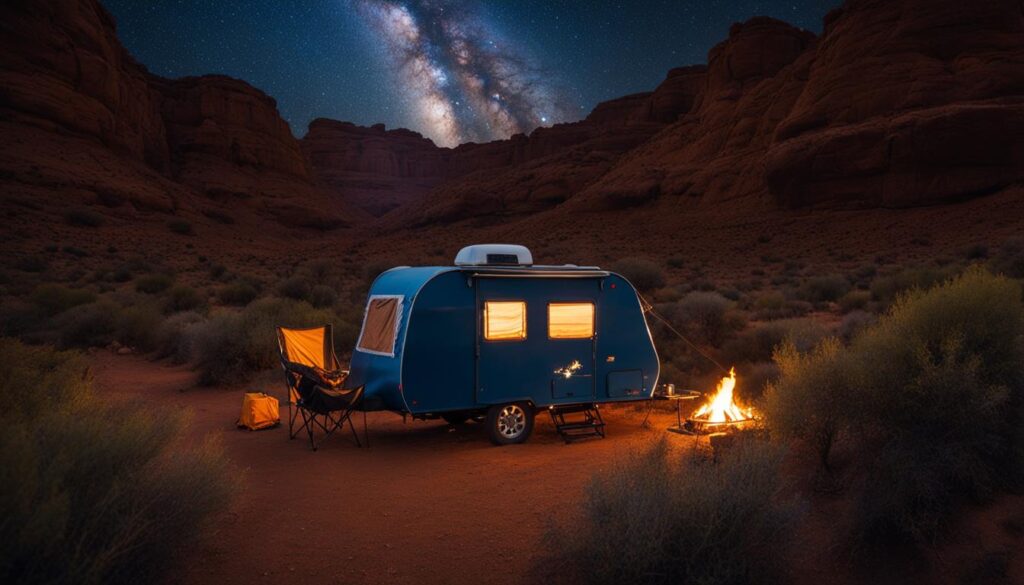Dry camping, also known as boondocking, is a popular style of camping that offers a unique and rewarding experience for outdoor enthusiasts. But what exactly is dry camping? In simple terms, dry camping refers to camping in an RV, van, or motorhome without any hookups (electricity or water) outside of a traditional campground.
Unlike traditional camping, dry camping allows you to fully immerse yourself in the beauty of nature without the constraints of designated campsites. Whether you choose to camp on public lands or private places with permission from the owner, dry camping opens up a world of possibilities for adventurous travelers.
Key Takeaways:
- Dry camping, also known as boondocking, is camping in an RV without hookups.
- It offers the freedom to camp in natural landscapes and a more private camping experience.
- Permission is required from landowners or managers to legally dry camp.
- Dry camping requires self-sufficiency in water, power, and basic needs.
- Researching rules, regulations, and best locations is essential for a successful dry camping experience.
Contents
Advantages of Dry Camping
Dry camping, also known as boondocking, offers a range of advantages that make it an appealing option for outdoor enthusiasts. While there are a few drawbacks, the benefits of dry camping outweigh the cons for many campers.
Benefits of Dry Camping
- Cost Savings: One of the biggest benefits of dry camping is that it’s usually free or significantly cheaper than traditional RV campgrounds. Instead of paying for campsite hookups, campers can save money and allocate those funds towards other travel expenses.
- Flexibility and Freedom: Dry camping provides campers with the freedom to choose their own campsite locations. Whether it’s a secluded spot in the wilderness or a scenic area by a lake, campers have the flexibility to explore and immerse themselves in nature.
- Privacy: Dry camping allows for a more private camping experience, away from the crowded and busy RV parks. Campers can enjoy peaceful surroundings and have more space to themselves, creating a tranquil and relaxing atmosphere.
- Nature and Scenery: By choosing dry camping, campers can access remote areas and natural landscapes that are often not available in traditional campgrounds. From breathtaking mountain views to serene forests, dry camping allows for a closer connection with the great outdoors.
“Dry camping provides campers with the freedom to choose their own campsite locations.”
Considerations
It’s important to note that dry camping has a few considerations that campers should be aware of:
- Self-Sufficiency: Dry camping requires campers to be self-sufficient in terms of water, power, and supplies. This means that careful planning and preparation are necessary to ensure a comfortable camping experience.
- Legal Restrictions: While dry camping is legal in many areas, there may be specific rules and regulations that campers need to follow. It’s essential to research and understand the restrictions of the area where you plan to dry camp.
- Additional Preparation: Compared to camping with hookups, dry camping often requires more work and preparation. Campers need to bring their own water, power sources, and essential supplies. Adequate planning and organization are crucial to ensure a smooth dry camping experience.
Despite these considerations, the benefits of dry camping make it an enticing choice for campers seeking adventure, solitude, and a closer connection with nature. By weighing the pros and cons, campers can make an informed decision about whether dry camping is right for them.

How to Prepare for Dry Camping
Before embarking on a dry camping trip, it is essential to be fully prepared. Having the right gear and supplies can make your experience more enjoyable and ensure a smooth camping adventure. Here are some tips on how to prepare for dry camping:
Gear and Equipment
- Ensure your RV or van is in good working order before setting off on your trip. Check the tires, brakes, and all mechanical systems to avoid any unexpected breakdowns.
- Invest in essential gear such as a reliable camping stove, portable water filter, and compact camping chairs and tables.
- Consider bringing backup power sources like solar panels or generators to ensure you have electricity when needed.
- Pack emergency supplies such as flashlights, batteries, a first-aid kit, and a fire extinguisher.
Food and Water
- Stock up on non-perishable food items that are easy to prepare and require minimal cooking equipment.
- Bring enough drinking water for the duration of your trip, as clean water may not be readily available at dry camping locations.
- If possible, carry extra water for cleaning and other purposes.
- Consider using a portable water filter to purify water from natural sources if needed.
Rules and Regulations
- Research and understand the rules and regulations of the specific area where you plan to dry camp. Some locations may have restrictions on camping, fires, or other activities.
- Obtain any necessary permits or permissions required for camping in the designated area.
- Respect the environment and leave no trace by following proper camping etiquette and cleaning up after yourself.

By following these tips and ensuring you have the necessary gear and supplies, you can be well-prepared for a successful dry camping trip. Remember to plan ahead, conserve resources, and respect the environment to make the most of your outdoor adventure.
Best Locations for Dry Camping
Dry camping offers the opportunity to immerse yourself in nature while enjoying the freedom of camping without hookups. Whether you prefer remote wilderness or closer proximity to amenities, there are plenty of options for the best locations for dry camping.
National Forests and National Parks
If you’re seeking pristine natural landscapes and the tranquility of the wilderness, national forests and national parks are excellent choices for dry camping. These protected areas often offer designated dispersed camping sites where you can camp for free or at a minimal cost. Some popular national forests for dry camping include:
- Shasta-Trinity National Forest, California
- Apache-Sitgreaves National Forest, Arizona
- Ozark-St. Francis National Forest, Arkansas
National parks such as Yosemite, Glacier, and Yellowstone also provide opportunities for dry camping. While some parks have restrictions on dispersed camping, they may have designated areas or campgrounds specifically for dry camping.
State Parks
State parks are another great option for dry camping, especially if you prefer a more developed camping experience with amenities like restrooms and picnic areas. Many state parks have dry camping areas that offer beautiful natural surroundings and a range of recreational activities. Some popular state parks that allow dry camping include:
- Deception Pass State Park, Washington
- Devil’s Lake State Park, Wisconsin
- Anastasia State Park, Florida
Private Lands with Permission
If you have access to private lands and obtain permission from the owner, you can enjoy dry camping in unique and picturesque locations. Some private landowners allow dry camping on their property, whether it’s a secluded meadow or a scenic hillside. It’s important to always respect the landowner’s rules and guidelines and leave no trace behind.
Established Campgrounds
Many established campgrounds offer dry camping options with shared amenities such as water spigots, bathrooms, and dump stations. These campgrounds often have designated areas for dry camping, providing a balance between enjoying nature and having access to essential facilities. Some well-known camping destinations with dry camping options include:
- Colorado Bend State Park, Texas
- Black Rock Desert-High Rock Canyon Emigrant Trails National Conservation Area, Nevada
- Wrangell-St. Elias National Park and Preserve, Alaska
Moochdocking and Parking Lots
If you’re looking for unique dry camping experiences, moochdocking and parking lots are worth considering. Moochdocking involves camping on someone’s land or in their driveway (with their permission), while some businesses like Walmart and Cabela’s allow overnight parking for RVs. These options provide a convenient and often cost-free way to enjoy dry camping while being close to amenities.

Choosing the best location for your dry camping adventure depends on your preferences, desired level of solitude, and the amenities you require. Remember to research and plan ahead to ensure a smooth and enjoyable dry camping experience.
Tips for Dry Camping Success
When it comes to dry camping, proper planning and preparation are key to a successful experience. Follow these tips to make the most out of your dry camping trip:
1. Bring enough water, power, and supplies: Before heading out, ensure you have an ample supply of water for drinking, cooking, and washing. Consider investing in portable water containers or carrying extra water jugs. Additionally, make sure you have enough power to sustain your camping needs, whether it’s through solar panels, a generator, or sufficient batteries. Stock up on non-perishable food items and basic camping supplies to last the duration of your trip.
2. Conserve water and electricity: To maximize your dry camping experience, practice water and electricity conservation. Use water sparingly, take quick showers, and opt for efficient appliances and fixtures. LED lights and solar-powered gadgets are excellent choices for reducing electricity consumption. By being conscious of your usage, you can extend your stay and minimize your environmental impact.
3. Know the rules and regulations: Familiarize yourself with the specific rules and regulations of the area where you plan to dry camp. Some public lands may have limitations on the length of stay or certain restrictions. If you’re camping on private land or in parking lots, always seek permission from the property owner beforehand. Respecting the rules ensures a smooth camping experience and helps maintain positive relationships with landowners.
4. Practice good etiquette and leave no trace: Leave the campsite as you found it, or even better. Clean up after yourself, dispose of waste properly, and leave no trace of your presence. This helps preserve the natural beauty of the area and ensures a pleasant experience for future campers. Remember, we are all responsible for protecting our environment.
By implementing these dry camping tips, you can enjoy the freedom and solitude of dry camping while minimizing potential challenges. Plan ahead, be well-prepared, and respect the land you’re camping on for a rewarding and memorable dry camping adventure.
FAQ
What is dry camping?
Dry camping, also known as boondocking, refers to camping in an RV, van, or motorhome without any hookups (electricity or water) outside of a traditional campground.
What are the benefits of dry camping?
Dry camping offers the freedom to camp in natural landscapes, is usually free or low-cost, provides more flexibility in choosing campsite locations, and allows for a more private camping experience.
What are the disadvantages of dry camping?
The disadvantages of dry camping include legal restrictions, the need to be self-sufficient in terms of water, power, and supplies, and the additional work and preparation required compared to camping with hookups.
How do I prepare for dry camping?
To prepare for dry camping, you should have a reliable RV or van in good working order, stock up on food and water supplies, have backup power sources, and have emergency supplies on hand. Researching and understanding the rules and regulations of the area where you plan to dry camp is also crucial.
Where are the best locations for dry camping?
Dry camping can be done in a variety of locations, including national forests, national parks, state parks, and private lands with permission. Many established campgrounds in these areas offer dry camping options with amenities. Moochdocking and camping in parking lots of businesses are also options.
What are some tips for dry camping success?
Tips for dry camping success include planning ahead, being prepared with enough water, power, and supplies, conserving water and electricity usage, being mindful of rules and regulations, asking for permission before camping on private land or in parking lots, and practicing good etiquette and leaving no trace.






